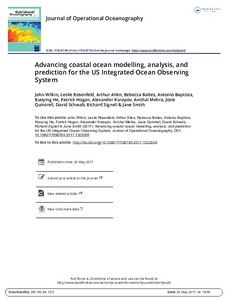| dc.contributor.author | Wilkin, John | |
| dc.contributor.author | Rosenfeld, Leslie | |
| dc.contributor.author | Allen, Arthur | |
| dc.contributor.author | Baltes, Rebecca | |
| dc.contributor.author | Baptista, Antonio | |
| dc.contributor.author | He, Ruoying | |
| dc.contributor.author | Hogan, Patrick | |
| dc.contributor.author | Kurapov, Alexander | |
| dc.contributor.author | Mehra, Avichal | |
| dc.contributor.author | Quintrell, Josie | |
| dc.contributor.author | Schwab, David | |
| dc.contributor.author | Signell, Richard | |
| dc.contributor.author | Smith, Jane | |
| dc.date.accessioned | 2018-12-18T21:55:11Z | |
| dc.date.available | 2018-12-18T21:55:11Z | |
| dc.date.issued | 2017 | |
| dc.identifier.citation | Wilkin, J.; Rosenfeld, L.; Allen, A.; Baltes. R.; Baptista, A.; He, R.; Hogan, P.; Kurapov, A.; Mehra, A.; Quintrell, J.; Schwab, D.;
Signel, R. and Smith, J. (2017) Advancing coastal ocean modelling, analysis, and prediction
for the US Integrated Ocean Observing System. Journal of Operational Oceanography, DOI:
10.1080/1755876X.2017.1322026 | en_US |
| dc.identifier.uri | http://hdl.handle.net/11329/603 | |
| dc.identifier.uri | http://dx.doi.org/10.25607/OBP-166 | |
| dc.description.abstract | This paper outlines strategies that would advance coastal ocean modelling, analysis and prediction
as a complement to the observing and data management activities of the coastal components of
the US Integrated Ocean Observing System (IOOS®) and the Global Ocean Observing System
(GOOS). The views presented are the consensus of a group of US-based researchers with a crosssection of coastal oceanography and ocean modelling expertise and community representation
drawn from Regional and US Federal partners in IOOS. Priorities for research and development
are suggested that would enhance the value of IOOS observations through model-based
synthesis, deliver better model-based information products, and assist the design, evaluation,
and operation of the observing system itself. The proposed priorities are: model coupling, data
assimilation, nearshore processes, cyberinfrastructure and model skill assessment, modelling for
observing system design, evaluation and operation, ensemble prediction, and fast predictors.
Approaches are suggested to accomplish substantial progress in a 3–8-year timeframe. In
addition, the group proposes steps to promote collaboration between research and operations
groups in Regional Associations, US Federal Agencies, and the international ocean research
community in general that would foster coordination on scientific and technical issues, and
strengthen federal–academic partnerships benefiting IOOS stakeholders and end users. | en_US |
| dc.language.iso | en | en_US |
| dc.subject.other | Data assimilation | en_US |
| dc.subject.other | Coastal ocean modelling | en_US |
| dc.subject.other | Observing systems | en_US |
| dc.subject.other | IOOS | |
| dc.subject.other | GOOS | |
| dc.title | Advancing coastal ocean modelling, analysis, and prediction for the US Integrated Ocean Observing System. | en_US |
| dc.type | Journal Contribution | en_US |
| dc.description.refereed | Refereed | en_US |
| dc.identifier.doi | 10.1080/1755876X.2017.1322026 | |
| dc.subject.parameterDiscipline | Parameter Discipline::Physical oceanography | en_US |
| dc.bibliographicCitation.title | Journal of Operational Oceanography | en_US |
| dc.description.bptype | Best Practice | en_US |
| dc.description.bptype | Standard Operating Procedure | en_US |
| obps.contact.contactemail | jwilkin@rutgers.edu | |
| obps.resourceurl.publisher | http://oomg.meas.ncsu.edu/wp-content/uploads/2017/05/IOOS_JOO_WilkinEtAl_2017.pdf | en_US |
 Repository of community practices in Ocean Research, Applications and Data/Information Management
Repository of community practices in Ocean Research, Applications and Data/Information Management
